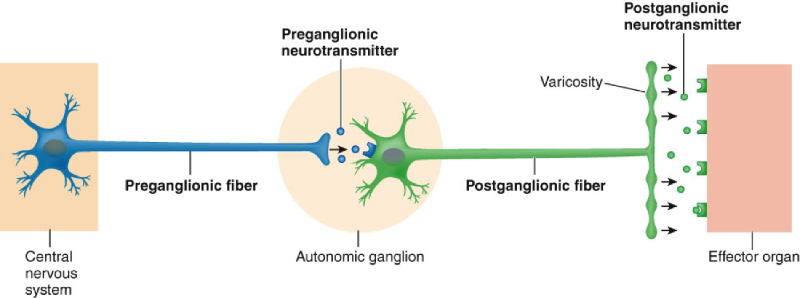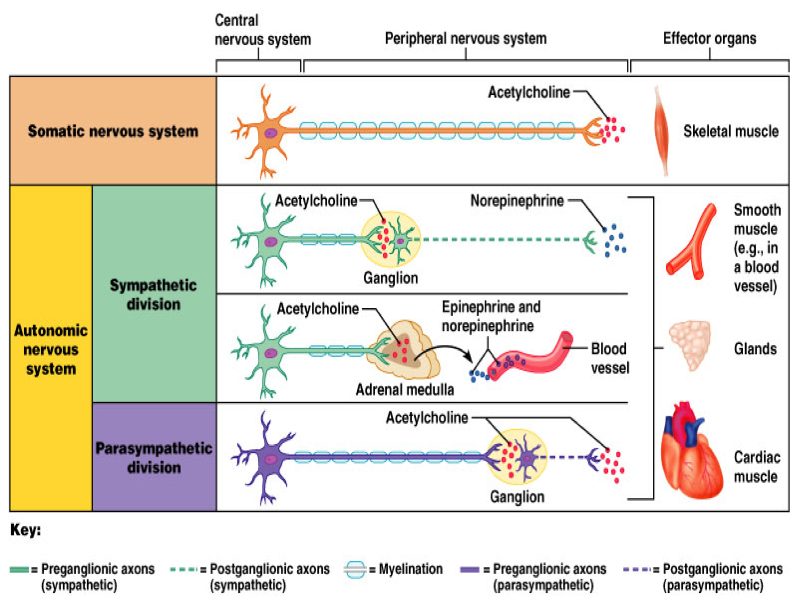What makes up the Peripheral Nervous System and the Central Nervous System? Be sure to include ALL of the subdivisions.
Central Nervous System (CNS) –
–Brain and spinal cord
Peripheral Nervous System (PNS) –
–Made up of nerves that attach to CNS
arms, legs, hands, and feet
Subdivisions of the PNS include the Somatic nervous system and the autonomic nervous system.
Review the arrangement of sensory, motor, and association neurons.
Sensory – transmit impulses from skin or other organs toward CNS
Motor – carry impulses away from CNS to effector organs
Association (interneurons) – lie between motor and sensory neurons
Compare and contrast afferent and efferent transmission.
...
Compare and contrast the somatic and autonomic nervous system in terms of structure AND function. Somatic Nervous System
Controls voluntary and involuntary skeletal muscle contractions
Involuntary skeletal contraction – reflex
Single neuron system
Compare and contrast the somatic and autonomic nervous system in terms of structure AND function. Autonomic Nervous System
Controls activity of smooth and cardiac muscles
2 neuron system
- 1st: from CNS to ganglion
- 2nd: from ganglion to effector
What is the name given to the branch of the nervous system that is responsible for the fight or flight response mechanism?
Sympathetic division
What is the name given to the branch of the nervous system that is responsible for resting and digesting?
Parasympathetic division
Describe the main differences between the sympathetic nervous system and parasympathetic nervous system. List multiple examples of what each system does. Sympathetic Nervous System
“ Fight or flight” response
Release adrenaline and noradrenaline
Increases heart rate and blood pressure
Increases blood flow to skeletal muscles
Sweat gland activated
Inhibits digestive functions
Describe the main differences between the sympathetic nervous system and parasympathetic nervous system. List multiple examples of what each system does. Parasympathetic Nervous System
“ Rest and digest ” system
Salivary and digestive glands activated
Urination and defecation stimulated
Calms the rest of the body to conserve and maintain energy
Lowers heartbeat, breathing rate, blood pressure
Diagram AND label the arrangement of a preganglionic fiber, ganglion cell, postganglionic fiber, and effector organ. Make sure to include the synapses!

Describe the arrangement, including lengths, of preganglionic and postganglionic fibers in the sympathetic nervous system.
Preganglionic fibers are SHORT
Postganglionic fibers are LONG
Preganglionic neurons located between segments T1 and L2 of spinal cord
Compare and contrast the locations, targets, AND functions of sympathetic chain ganglia, collateral ganglia, and ganglia found in the adrenal medulla.
The Sympathetic chain ganglia innervates visceral effectors via spinal nerves and also innervates visceral organs in the thoracic cavity via sympathetic nerves.
Target organs are visceral effectors in the thoracic cavity, head, body wall, and limbs.
Compare and contrast the locations, targets, AND functions of sympathetic chain ganglia, collateral ganglia, and ganglia found in the adrenal medulla.
The collateral ganglia innervates visceral effectors in the abdominal cavity.
Compare and contrast the locations, targets, AND functions of sympathetic chain ganglia, collateral ganglia, and ganglia found in the adrenal medulla.
Targets are organs and systems throughout the body.
It secretes neurotransmitters into general circulation.
Describe the arrangement, including lengths, of preganglionic and postganglionic fibers in the parasympathetic nervous system.
Preganglionic fibers are LONG
Postganglionic fibers are SHORT
Preganglionic fibers originate in brain stem and sacral segments of spinal cord
Compare and contrast the locations, targets, AND functions of the ganglia in the parasympathetic nervous system.

What is the neurotransmitter involved at the synapse between the preganglionic and postganglionic cells of BOTH the sympathetic and parasympathetic nervous system?
Ach
Diagram the neurotransmitters involved between the postganglionic cell and the target organ/gland in BOTH the sympathetic and parasympathetic nervous system.

Compare and contrast the locations and functions of nicotinic and muscarinic acetylcholine receptors.
***Nicotinic R eceptors
–On surfaces of ALL ganglion cells (sympathetic AND parasympathetic)
–ALSO found at the NEUROMUSCULAR JUNCTION in the SOMATIC NERVOUS SYSTEM
***Muscarinic Receptors
–At the neuromuscular or neuroglandular junctions (parasympathetic)
–At few cholinergic junctions (sweat glands innervated by the sympathetic nervous system)
Describe the pathophysiology of BOTH nicotine poisoning and muscarine poisoning. Ask yourself WHY a person would experience the symptoms associated with each type of poisoning. Think of what is happening at the receptors! NICOTINE POISONING
Nicotine:
–binds to nicotinic receptors
–targets autonomic ganglia and skeletal neuromuscular junctions
Symptoms:
–vomiting, diarrhea, high blood pressure, rapid heart rate, sweating, profuse salivation, convulsions
- May result in coma or death
Describe the pathophysiology of BOTH nicotine poisoning and muscarine poisoning. Ask yourself WHY a person would experience the symptoms associated with each type of poisoning. Think of what is happening at the receptors! MUSCARINE POISONING
Muscarine:
–binds to muscarinic receptors
–targets parasympathetic neuromuscular or neuroglandular junctions
Symptoms:
–salivation, nausea, vomiting, diarrhea, constriction of respiratory passages, low blood pressure, slow heart rate (bradycardia)
What does adrenergic mean?
Aka SYMPATHOMIMETIC
Activated by, characteristic of, or secreting epinephrine, or
substances with similar activity
Compare and contrast the following receptors, in detail:
- Alpha 1
- Alpha 2
Alpha-1 ( a 1 )
–More common type of alpha receptor
–Releases intracellular calcium ions from reserves in endoplasmic reticulum
–What will this do to the smooth muscle cells in the wall of an artery? Vasoconstrict
Alpha-2 ( a 2 )
–Suppresses release of epinephrine
–Can lead to vasodilation of blood vessels
Compare and contrast the following receptors, in detail:
- Beta 1
- Beta 2
Affect membranes in many organs (skeletal muscles, lungs, heart, and liver)
Beta-1 ( b 1 )
–Increase in heart rate (chronotropy) and strength of contractions (ionotropy)
Beta-2 ( b 2 )
–Triggers relaxation of smooth muscles along respiratory tract and wall of uterus
Beta-3 ( b 3 )
–Is found in adipose tissue
–Leads to lipolysis, the breakdown of triglycerides in adipocytes
–Releases fatty acids into circulation
Why does Primack’s wife carry an epi-pen with her? Hint: Bees!
Why would a person with heart disease (a damaged heart muscle) take Atenolol (a b-1 Antagonist) – commonly called a Beta Blocker?
Why else might someone be prescribed Atenolol on a PRN (as needed) basis?
Why would a person having an asthma attack take Albuterol (a b-2 Agonist)? Why does their heart race increase when taking this drug????????? Would you expect this to happen? Why or why not?
Why would a female be administered terbutaline (a b-2 Agonist) during pregnancy?
Come up with two different ways to pharmacologically treat hypertension using drugs which target adrenergic receptors
Review
Autonomic Innervation: The Heart
Receives dual innervation
2 divisions have opposing effects:
–parasympathetic division:
- acetylcholine released by postganglionic fibers slows in heart rate
–sympathetic division:
- NE released accelerates heart rate
- Balance between 2 divisions:
–autonomic tone is present
–releases small amounts of both neurotransmitters continuously
–Parasympathetic innervation dominates under resting conditions
Crisis accelerates heart rate by:
–stimulation of sympathetic innervation
inhibition of parasympathetic innervation
Autonomic Innervation: Blood Vessel Dilation
Blood vessel dilates and blood flow increases
Blood vessel constricts and blood flow reduced
Sympathetic postganglionic fibers release NE:
–innervate smooth muscle cells in walls of peripheral vessels
Background sympathetic tone keeps muscles partially contracted
To increase blood flow:
–rate of NE release decreases
–smooth muscle cells relax
–vessels dilate and blood flow increases